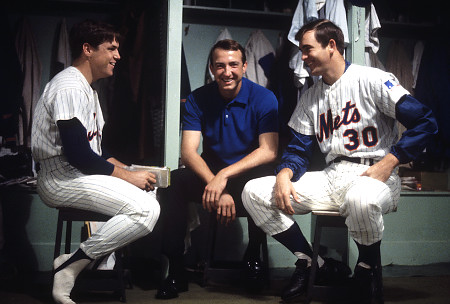 You can learn a lot about a baseball team from its locker room. The clubhouse is where relationships form, character is revealed and leaders speak out (or not). For the major league rookie, clubhouse real estate is valuable — sometimes priceless. Imagine being the rookie who spent eight months out of the year next to Sandy Koufax? Roberto Clemente? Lou Gehrig? Tom Seaver? These were model athletes, wise and humble men, who used their talent to teach.
You can learn a lot about a baseball team from its locker room. The clubhouse is where relationships form, character is revealed and leaders speak out (or not). For the major league rookie, clubhouse real estate is valuable — sometimes priceless. Imagine being the rookie who spent eight months out of the year next to Sandy Koufax? Roberto Clemente? Lou Gehrig? Tom Seaver? These were model athletes, wise and humble men, who used their talent to teach.
Danny Frisella and Tug McGraw were in heated competition for fame and fortune from the outset of the 1972 season. The late Gil Hodges remembers both pitchers begging for their manager to pick them when he signaled to the bullpen. If Frisella was selected, and won the game, McGraw would give Frisella the “cold shoulder.” If McGraw got the nod (and won) Frisella would mimic the gesture.
There is no evidence whether or not the Mets clubhouse manager made an intentional effort to put Frisella and McGraw side-by-side in the locker room, but their adjoining lockers created more fun and competition. The two Mets pitchers would sometimes switch the locker nameplates to appear that the other won the game.
While Frisella and McGraw jockeyed for their manager’s affection, that same season a rookie named Jon Matlack was granted locker space between Tom Seaver and Jerry Koosman. Matlack was named 1972 Rookie of the Year, winning 15 of his 32 starts. He compiled 244 innings pitched, eight complete games and a skinny 2.32 ERA. Coincidence? Possibly. Seaver will tell you, for certain, it meant nothing then and means nothing now.
“Where you lockered really wasn’t that important,” Seaver told the New York Times in 2008. “It didn’t make any difference. Just your own little space; it could have been anywhere.”
For Seaver, locker space was irrelevant. It was a place – and space – where he took out his frustrations after a poor start. “When I make a mistake and beat myself with a bad pitch, then I get kicking mad and go after stools and water buckets,” Seaver told People Magazine.
Other times, Seaver used his locker as a prop. After getting off to a slow start in 1974, a Mets beat writer asked him if he had lost his fastball. Seaver paused, then started rummaging in his locker muttering, “Where are you, fastball? Are you in there somewhere?”
Seaver didn’t need sabermetrics to figure out the 1975 New York Mets were in for a long year. The Mets, a team renowned for their pitching stock, found themselves lacking. That spring, Seaver sat on a stool in front of his locker and looked up at the adjoining lockers. SEAVER. KOOSMAN, MATLACK.
Who are the rest of these guys? Seaver thought. “That’s Nos. 1, 2 and 3. Where are 4 and 5?” He rolled his eyes in frustration.
He knew, if something doesn’t change (and it didn’t), the Mets would not compete. The Mets were within four games of the lead in the National League East on September 1, 1975; then the bottom fell out on the season. They finished in third place 10 ½ games behind the Pittsburgh Pirates.
Seaver’s real estate at Shea Stadium was the site where many of the organizations proudest moments were celebrated. He sprayed champagne over the heads of his teammates in 1969 from that “little space.” Seaver helped the Mets win another National League title from that hole in the wall. He encouraged and mentored Matlack, Jackson Todd, Bob Myrick, George Stone and many others within earshot.
In one respect Seaver is right; a locker isn’t important. There’s nothing glamorous about an athlete’s locker. It’s literally a hole in the wall. For the common man, a locker is a lot like an office cubicle, a place to store your personal effects while you go take care of business. But, location is valuable, sometimes educational.
“I learned an awful lot from having my locker room stuck between Koosman and Seaver,” said Matlack. “”It was a very, very good location to be in.”
Seaver’s locker was physically unique, well, maybe for its modesty. Former Mets beat writer Marty Noble described the space this way: “there was no locker to the immediate left, just a three-foot-wide panel. A trash can was placed there.” Seaver’s “little space” was nondescript. Seaver, himself, was so Seaver was so impervious to his surroundings that, to this day, he is unsure whether he had the now famous locker space his rookie year of 1967.
Over time, Seaver’s locker took on a life of its own. After he we traded in June 1977, Bud Harrelson asked if he could move in. Not happening, said Mets equipment manager Herb Norman. The locker would be assigned to Seaver’s successor, Pat Zachry.
Seaver returned home, and to his “little space” in 1983, then, Ron Darling assumed the space from 1984-1991, followed by David Cone (July 1991-August 1992), John Franco (1992-2003), Steve Trachsel (2004-2006) and Aaron Heilman (2007).
“That locker did have history; more than any other in that place,” said Franco. “Nobody made the kind of history here that Tom Seaver made. It doesn’t matter how long anyone had it, it was always Seaver’s.”
“It doesn’t matter [who preceded Seaver],” added Darling. “It’s his.”
In some ballparks, because of some professional athletes, lockers can become hallowed ground. When Lou Gehrig died, his locker was sealed and sent to Cooperstown. Before Shea Stadium was demolished after the 2008 season, Seaver’s locker was preserved and put on the block for a cool $41,000.
That’s some valuable real estate.
In 1984, the New York Mets were on the rise. Jesse Orosco and Doug Sisk anchored the Mets bullpen on the field, roommates off the field and lived out of adjoining lockers during the team’s championship run in the 80s.
“We’re just a couple of ordinary guys who get along, and have no professional jealousy,” said Sisk. “We’re both fairly serious, but we have different personalities. But we’re not rivals. You can’t be rivals. It won’t work.”
When it does work, the team benefits – at least that’s what Mets manager Terry Collins hopes will happen by placing Zack Wheeler and Matt Harvey side-by-side in Port St. Lucie. Collins told the media he intentionally put Harvey, 23, and Wheeler, 22, at adjoining lockers to give Wheeler the opportunity to ask questions and “soak up” the experience like Harvey did last season.
“Having lockers next to each other, we’re both baseball players who have the same mindset,” said Harvey. “Getting along, I don’t think, is going to be very tough.”
Wheeler has prime real estate in Port St. Lucie. Like Harvey in 2012, he will receive a valuable education a lot by watching and listening. Harvey described the experience as “eye-opening.” Last spring he watched Johan Santana, R.A. Dickey, Jonathon Niese and Dillon Gee prepare for a major league baseball season.
“That’s something that I’ve never seen,” Harvey told ESPN.com. “Watching the preparation that those guys had in order to throw 200 innings … Sometimes it’s stepping back and realizing, ‘Hey, this is a long process. Throwing until the end of September is a long time from now.'”
Let’s be honest here, Harvey is still learning too. Collins hopes the location will be the seed to a long-term successful relationship between his two future stars.
Spring Training, which officially starts today, is always an intriguing place for reporters to take stock in how and where players are positioned. The nameplates begin to disappear as February turns to March and the minor league players are dispatched for reassignment. The last days of March mark the time for final cuts. The veteran invited to spring training is playing his heart out and biting their nails in one corner of the clubhouse while the fresh-faced 20-something is bouncing off the walls hoping this will be his year.
As Opening Day creeps closer, locker room real estate values will increase.













